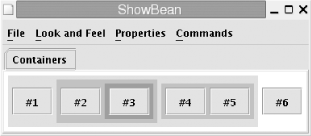11.2 Containers
| The second step in creating a GUI is to place the components you have created and configured into appropriate containers. Chapter 2 of Java Foundation Classes in a Nutshell contains tables that list the container classes available in the AWT and Swing packages. Many of these container classes have specialized uses. JFrame is a top-level window, for example, and JTabbedPane displays the components it contains in individual tabbed panes (like those pictured in Figure 11-1) but Swing and the AWT also define generic container classes, such as JPanel. Example 11-1 is a listing of Containers.java. This class is a subclass of JPanel. Its constructor method creates a number of other nested JPanel instances, as well as a number of JButton objects contained by those JPanel classes. Example 11-1 illustrates the concept of the containment hierarchy of a GUI, using color to represent the nesting depth of the hierarchy. Figure 11-2 shows what the Containers class looks like when displayed with the ShowBean program as follows: % java je3.gui.ShowBean je3.gui.Containers Figure 11-2. Nested containers Example 11-1. Containers.javapackage je3.gui; import javax.swing.*; import java.awt.*; /** * A component subclass that demonstrates nested containers and components. * It creates the hierarchy shown below, and uses different colors to * distinguish the different nesting levels of the containers * * Containers---panel1----button1 * | |---panel2----button2 * | | |----panel3----button3 * | |------panel4----button4 * | |----button5 * |---button6 */ public class Containers extends JPanel { public Containers( ) { this.setBackground(Color.white); // This component is white this.setFont(new Font("Dialog", Font.BOLD, 24)); JPanel p1 = new JPanel( ); p1.setBackground(new Color(200, 200, 200)); // Panel1 is darker this.add(p1); // p1 is contained by this component p1.add(new JButton("#1")); // Button 1 is contained in p1 JPanel p2 = new JPanel( ); p2.setBackground(new Color(150, 150, 150)); // p2 is darker than p2 p1.add(p2); // p2 is contained in p1 p2.add(new JButton("#2")); // Button 2 is contained in p2 JPanel p3 = new JPanel( ); p3.setBackground(new Color(100, 100, 100)); // p3 is darker than p2 p2.add(p3); // p3 is contained in p2 p3.add(new JButton("#3")); // Button 3 is contained in p3 JPanel p4 = new JPanel( ); p4.setBackground(new Color(150, 150, 150)); // p4 is darker than p1 p1.add(p4); // p4 is contained in p1 p4.add(new JButton("#4")); // Button4 is contained in p4 p4.add(new JButton("#5")); // Button5 is also contained in p4 this.add(new JButton("#6")); // Button6 is contained in this component } } |
EAN: 2147483647
Pages: 285
- Challenging the Unpredictable: Changeable Order Management Systems
- ERP System Acquisition: A Process Model and Results From an Austrian Survey
- The Effects of an Enterprise Resource Planning System (ERP) Implementation on Job Characteristics – A Study using the Hackman and Oldham Job Characteristics Model
- Healthcare Information: From Administrative to Practice Databases
- Development of Interactive Web Sites to Enhance Police/Community Relations